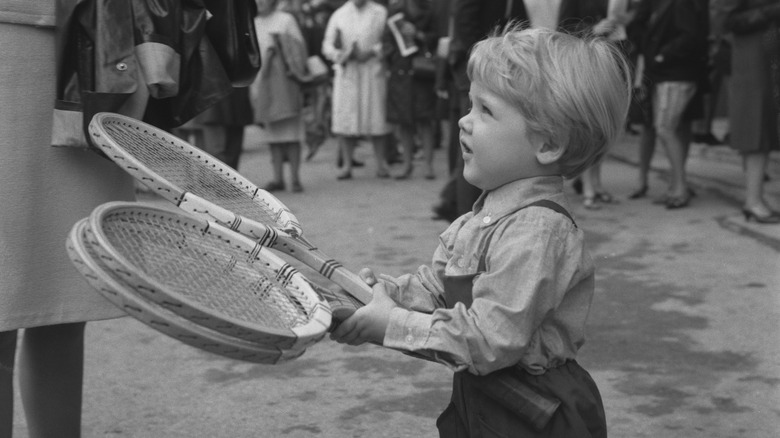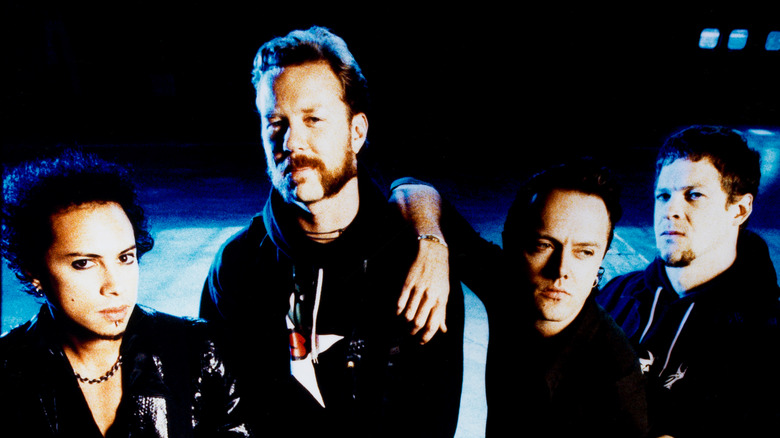The Untold Truth Of Metallica
Compared to many other genres, heavy metal isn't particularly conducive to crossover success. Some of the absolute greatest metal bands out there may be highly revered amongst metalheads, but if you're not into the hard and heavy stuff, they're often reduced to a passing name recognition and, perhaps, one or two half-remembered songs. As such, the back catalog of bands like, say, Slayer and Pantera can be so far removed from mellower musical tastes that their rightful place in the annals of music history might as well be invisible (though never inaudible) to the average music fan.
This background makes the rise and rule of Metallica all the more strange and exciting. Whether you love or loathe their music, few can deny that the thrash metal juggernauts have become one of the biggest bands to ever exist. But how did they go from a group of long-haired young men with a bunch of extremely loud tunes and a propensity for mayhem to the reigning kings of stadium-sized metal? The short answer is that it's been a hell of a bumpy ride. The long answer, on the other hand, requires a long, hard look at the untold truth of Metallica.
James Hetfield grew up in a Christian Science family
With his roaring vocals, rambunctious rhythm guitar, scowling expression, and facial hair choices that scream "this man owns several denim vests full of band patches," it's difficult to imagine James Hetfield doing anything but fronting the biggest heavy metal group out there. However, as Hetfield told Metal Hammer in 2020, his early life had little to do with heavy metal heroics. Hetfield grew up in Los Angeles as a self-professed quiet, average kid ... with one notable difference. The musician's family was in the Cristian Science Church, and its practices had a strong effect on young James.
"Our parents didn't take us to the doctor," Hetfield explained. "We were basically relying on the spiritual power of the religion to heal us or to shield us from being sick or injured. And so at school I wasn't allowed to sit through health class, to learn about the body, to learn about illnesses and things like that. And, say, I'm trying out for the football team [and] you have to get a physical, to get a doctor's note, I'd have to go and explain to the coach that, you know, our religion says this. So I felt really like an outcast, and, you know, kids would laugh about it."
While Hetfield admits this wasn't always easy, he thinks of these hardships as important formative experiences ... as well as good practice for the whole "outcast" thing that aided him as a hard-rocking musician.
Lars Ulrich wanted to be a tennis pro
As the animated drummer of Metallica, Lars Ulrich's been in charge of arguably the most physical gig in the band throughout its existence. However, in an interview with Metal Hammer, he noted that he originally envisioned a very different — though no less sweaty — future for himself.
Ulrich is originally from Denmark, and the reason he found himself in California was, some might say, not exactly metal. The son of tennis pro Torben Ulrich (per Roland-Garros), Young Lars was also a very good tennis player in his home country, and the family moved Stateside in order for him to be able to rise to the highest echelons of the sport. However, Ulrich soon found that the classic phrase about a big fish in a small pond very much applied to him — or, more specifically, his tennis skills. "In Denmark I was ranked high enough to be one of the best tennis players in the country, but there's only five million people there," Ulrich said. "When we came to Newport Beach, I wasn't good enough to get on the tennis team at Corona del Mar High School. I wasn't one of the best 10 tennis players in the street that I lived on!"
Fortunately, Ulrich soon found another interest in heavy metal, and got heavily into the genre's early-1980s greats. "I was like, 'I want to form a band and play drums,' and off it went." Off it went, indeed.
The relationship between Ulrich and Hetfield has been a rollercoaster
Metallica was formed in 1981 after James Hetfield answered Lars Ulrich's newspaper ad (via Metallica's official website). The founding pair had some disagreements early on (via Loudwire) and the "Metallica: Some Kind of Monster" documentary in 2004 revealed that the pair wasn't averse to butting heads even two decades later (per Loudwire). However, they did develop a sort of brotherly chemistry very early, and even though they clashed on occasion, they very much had each other's backs — to the point that Ulrich has revealed that Hetfield often had to defend him on multiple occasions after he ran his mouth to the wrong people in their early days. "I would usually just run," Ulrich said. "I'd just f****** take off, but then James would clean it up for me and throw a few punches at some of these other guys."
As ABC News points out, a lot of the pair's conflict has stemmed from the fact that while they share a deep creative connection, they are very different people in virtually every way, and have had very different visions about the band on occasion. However, as of 2017, Ulrich noted that the pair have gotten to know and appreciate each other's viewpoints to a point that they work as a tighter unit than ever.
"We rarely argue over anything, and we try to see each other's point of view much more," the drummer said. "It's called growing up."
The band's lineup took a while to settle
Apart from the bass position, Metallica's lineup has been noticeably stable throughout the band's decades in the limelight. However, there was plenty of early installment weirdness while the band was taking its baby steps.
According to Ultimate Classic Rock, the very first Metallica lineup in 1981 consisted of founding members James Hetfield and Lars Ulrich, as well as a guitar player called Lloyd Grant, who helped record the nascent band's first song, "Hit the Lights." Grant, however, wasn't a permanent member. In 1982, Hetfield and Ulrich were joined by two new members, bassist Ron McGovney and guitarist (and future Megadeth founder) Dave Mustaine. There was also a very brief, unsuccessful experiment to include a fifth member, guitarist Brad Parker.
Over the spring of 1983, the band finally found its iconic early lineup. According to McGovney's interview on the Talk Is Jericho podcast (via No Treble), his clock started ticking the second he, Ulrich and Hetfield saw Cliff Burton play live. "I'm looking at [James and Lars], and they're looking at [Cliff], so I kind of knew right at that point," McGovney said. "Like, 'Yeah, this is the guy that they're gonna go after. I can feel it.'" However, he's said he had little problem with either Burton or leaving the group behind. Mustaine, per Loudwire, had a less peaceful exit. He was abruptly replaced with Kirk Hammett after Hetfield and Ulrich grew tired of his aggressive and unpredictable partying ways.
Cliff Burton's training was far from metal
Because James Hetfield and Lars Ulrich are the most visible members of Metallica and its principal songwriters, it's easy to assume that they're the musical be-all and end-all of the band. However, as Ultimate Classic Rock tells us, the biggest musical prodigy of the band's first iconic lineup just might have been the highly technical and musically far-reaching Cliff Burton, the bass player in Trauma. Hetfield and Ulrich were so keen to recruit him that they actually moved the band to San Francisco at Burton's behest. Hetfield has freely told Metal Hammer that the bass player stood head and shoulders above others when it came to sheer musical training.
"Besides introducing us to more music theory, he was the most schooled of any of us, he had gone to junior college to learn some things about music, and taught us quite a few things," Hetfield described Burton. "When Lars and I had seen him play with Trauma, our jaws fell onto the floor, and we said, 'We've got to get this guy.'"
Per All Metallica, there was a reason Burton was so good. After his brother died when he was 13, Burton reportedly made it his mission to become the best bass player he could be in his honor. Arduous training and multiple teachers made him a versatile player with knowledge of and appreciation for a multitude of genres, from jazz to classical music ... and, of course, heavy metal.
Kirk Hammett has an incredibly dark past
Kirk Hammett may seem like the most mellow guy in Metallica, but as the guitarist told Playboy in 2001 (via Loudwire), his backstory is easily the darkest of the long-term band members. "I was abused as a child," Hammett said. "My dad drank a lot. He beat the s*** out of me and my mom quite a bit. I got ahold of a guitar, and from the time I was 15, I rarely left my room. I remember having to pull my dad off my mom when he attacked her one time, during my 16th birthday—he turned on me and started slapping me around. Then my dad just left one day. My mom was struggling to support me and my sister. I've definitely channeled a lot of anger into the music."
Music and horror movies became the go-to escapes to young Hammett early on, and in a 2021 interview with the Backstaged: The Devil in Metal podcast (via Loudwire), he actually attributed his survival to his love of music. Per Metal Hammer, he gravitated toward the roughest music around, and soon established himself as one of the most pivotal figures in the thrash metal scene. After all, he's both a long-serving member of Metallica and a co-founder of fellow thrash giant Exodus.
If you or someone you know may be the victim of child abuse, please contact the Childhelp National Child Abuse Hotline at 1-800-4-A-Child (1-800-422-4453) or contact their live chat services.
Metallica gives back with lots and lots of charity
In 2018, the Finnish charity organization and food bank Veikko and Lahja Hursti Charitable Trust received the biggest surprise ever, when the representatives of Metallica contacted them (via Yle). Two weeks later the heavy metal juggernaut had played two shows in the country's capital, Helsinki, and members of the Hursti Trust found themselves posing for a group photo with the metal legends, holding a massive check for the local equivalent to a little over $28,000. "They got our contact information somehow and told us they wanted to make a donation," the charity's leader, Heikki Hursti said.
As an isolated incident, this might not seem like a massive thing for a multimillion-dollar operation that's rocking out the world's stadium venues one by one. However, it's worth remembering that there are stories like this everywhere the band goes. Wherever Metallica may roam — and in many places they don't — the band seems to take care to deploy their All Within My Hands foundation, which supports food banks, helps the homeless, and is involved in other worthy enterprises. Per Look to the Stars, the band supports multiple charities and causes.
Their charitable activities have added up to the point that in 2019, Forbes speculated that Metallica might even be the single most charitable band around.
Cliff Burton's tragic death sent the band in turmoil
The most terrifying low point in Metallica's history came on September 27, 1986 (via Metal Hammer). They were touring in Sweden when the tour bus slid on the icy road, and a nasty accident ensued. While the rest of the passengers survived with comparatively minor injuries, bassist Cliff Burton was less fortunate.
"[The bus] hit so-called black ice, skidded out and bounced once, and that's when he went through the window, and the bus went right on him," James Hetfield described the events that led to Burton's death to In the Studio. "It was pretty quick and I know he didn't know what hit him. Coming out and finding your buddy under the bus is not something you want to go through."
Scott Ian of Metallica's tourmates Anthrax — who met the pair after the accident — confirms Hetfield's state of mind at the time in his memoir (via Loudwire), which makes clear that the frontman was in deep, destructive despair. Kirk Hammett, meanwhile, has described his own initial reaction as sheer disbelief. Metallica returned on the road fairly shortly after the incident, which Hammett later came to believe was a mistake. "We didn't give ourselves enough time to recover from the grief," he said in 2016.
Jason Newsted had a difficult time in Metallica
In 1986, Metallica announced Jason Newsted as their new bassist after the tragic death of Cliff Burton, per Loudwire. Newsted came with stellar recommendations but replacing Burton so soon after his passing was a massive hurdle ... which Newsted himself was perfectly capable of clearing, but his senior bandmates evidently weren't.
The new guy was a natural target for the veterans' unresolved issues, and Newsted had to withstand plenty of ruthless antics from the others. However, while the fact that Newsted's first Metallica album, "... And Justice For All," has virtually no audible bass parts makes it easy to believe that the record was yet another low blow to the bassman, other band members have stated that the record's mix is unconnected to the other issues (via Guitar World).
Newsted stayed with Metallica for 14 years, and ultimately left in search of more creative endeavors in 2001. Though the others eventually came to understand the decision, Ulrich said in an interview with Apple Music (via NME) that they initially took it as an insult. "Jason is the only member of Metallica who has ever left willingly," the drummer said in 2021. "And that in itself is a statistic. And the resentment from James and I was just so ... You can't do that. You can only leave if we want you to leave. And then we weren't equipped at the time to do a deep dive into why he was leaving."
They've experimented with swapping roles
In any given lineup of Metallica, it can be very difficult to imagine any member playing anything but the exact instrument they're best known for. However, as Rock Celebrities tells us, the band has, on occasion, experimented with a radically different version of itself. In 1992, they performed their Diamond Head cover "Am I Evil?" by completely remixing their roles: Lars Ulrich took over the vocals, Kirk Hammett and Jason Newsted switched their guitar and bass duties, and James Hetfield sat behind the drums.
Per ABC News, this isn't the only time Metallica has entertained the idea of such role-play, and Hetfield even teased in the wake of their 2016 album "Hardwired ... to Self-Destruct" that he and Ulrich might tinker with switching roles at some point. "I'm eventually gonna play drums," Hetfield told during an appearance on Marc Maron's WTF podcast (via Metal Sucks) in early 2017. "This is hot news right now, I've never told anyone, but yeah, I'm working on being a drummer at some point ... and Lars wants to sing, so it's a good trade. Well, not for the listener, but [a] good trade for us."
However, the frontman's tone was clearly joking, and he's been quick to note that while they've tried the swap for real at a rehearsal, the combination of his comparatively training wheels-level drumming skills and Ulrich's flailing guitar antics and underwhelming vocal performance made them quickly abandon the attempt.
Metallica's early albums kept raising the bar
Whenever Metallica albums are ranked, there's a pretty good chance that their early albums end up ruling the roost. Per Metal Hammer and Kerrang!, the band's 1983 debut album "Kill 'Em All" took the building blocks of the nascent thrash metal genre and took things to a different level. The following year's "Ride the Lightning" refined the band's own sound and fully incorporated the talents of Kirk Hammett and Cliff Burton, and 1986's "Master of Puppets" somehow managed to further improve on that. With that string of amazing records, Metallica managed to sell millions of albums and became a major name with no music videos or hit singles — in other words, with little more than word-of-mouth to aid them (per Encyclopedia Britannica).
In a 2016 interview with The Guardian, drummer Lars Ulrich reflected on the band's early attitude at making records. "We had so much energy and belief," he said. "It's interesting how instinctive things used to be, how impulsive. I don't remember laboring over ideas or ways to do things. We just did it. When you're 21, you just do s***. When you're 51, everything is an ordeal."
A shift in direction brought even bigger success
Per Encyclopedia Britannica, Metallica's darkest hour also marked a new phase for the band. After the death of Cliff Burton and the arrival of Jason Newsted, Metallica continued exploring new directions, which involved embracing the age of the music video with "One," a staggering single from their 1988 album, "...And Justice For All." The song was accompanied by the band's very first video, a dark offering that features clips from the movie "Johnny Got His Gun" (via Ultimate Classic Rock).
According to Metal Hammer, the bass-free mix of "... And Justice For All" may be odd, but the sheer strength of the album's songs can't be denied. Even the few that may have attempted to resist Metallica's rise to the upper echelons of stardom had little to naysay after the band dropped their following album, 1991's Bob Rock-produced smash hit, "Metallica" — a.k.a. the massively successful "Black Album."
The Load-era hairstyles weren't a coordinated effort
A haircut can be news in the world of entertainment, but Metallica certainly got more than they bargained for when all four members of the band sported much shorter locks than people were used to during their "Load" album cycle (via The Chicago Tribune).
"I was surprised at how much reaction it got," Lars Ulrich described the backlash at the time, though he did note that he understands the root cause. "But I suppose I should have seen it coming. Metallica to a lot of people is metal, and there is a code, a lifestyle, an us-versus-them attitude that you have to observe to keep in everyone's good graces."
In a 2017 interview with WJRR (via Loudwire), Ulrich laughed at the way people believed that the haircuts were a carefully coordinated way to change their image. He noted that Jason Newsted actually opted for a bald hairstyle all the way back in 1993, and each of the other band members eventually ended up going for a shorter hair for reasons of their own. Kirk Hammett has told Dean Delray's Let There Be Talk podcast (via Ultimate Guitar) that his specific haircut was inspired by the vogue among his social circles at the time. Meanwhile, haircut originator Newsted has theorized that the others got the barber bug when they saw him repeatedly waltz through customs while they kept getting stopped, per The Metal Hammer Podcast (via Ultimate Guitar).
How Robert Trujillo became the million-dollar bass player
After the departure of the long-suffering Jason Newsted, things on the bass side of Metallica have been fairly stable, courtesy of his replacement, Robert Trujillo (per The Chicago Tribune). Trujillo may have joined Metallica during one of the lower lows in the band's history — the era depicted in the "Metallica: Some Kind of Monster" documentary. However, the talented bass player was a veteran of navigating difficult circumstances. After all, he'd played with some of the most notorious figures in the industry, including a certain Ozzy Osbourne.
"Musicians are interesting characters, man," Trujillo has described his approach. "It's always important to learn from your life experiences and take that with you into your job situation. You kind of see what people like and what makes them feel good, and how you balance a personality, and you can bring a better vibe to the atmosphere. I call it a gift — I think it is."
Seeing as Trujillo joined the band in 2003 and is still with them, it's easy to see that his bridge-building philosophy and outrageous bass guitar skills continue to be a valuable addition to Metallica's chemistry. So valuable, in fact, that when the band offered the gig to him, they further sweetened the deal with a cool $1 million (per Loudwire).
James Hetfield has struggled with alcohol abuse
In September 2019, Metallica released a statement on their official website, declaring the postponement of a planned tour. "As most of you probably know, our brother James has been struggling with addiction on and off for many years," the statement read. "He has now, unfortunately, had to re-enter a treatment program to work on his recovery again."
Per Louder and The Guardian, Metallica's historical relationship with alcohol and narcotics has been somewhat well-documented, and Hetfield's addiction issues, in particular, have been fairly public knowledge since the 2004 documentary "Metallica: Some Kind of Monster" revealed his rehab stint during the making of the "St. Anger" album (via Louder). While the frontman's issues in 2019 surprised the rest of the band (via Metal Hammer), they were supportive of their bandmate's situation. In 2020, Ulrich told NME that the band was "in a very healthy place."
If you or anyone you know is struggling with addiction issues, help is available. Visit the Substance Abuse and Mental Health Services Administration website or contact SAMHSA's National Helpline at 1-800-662-HELP (4357).
Metallica is an excellent cover band
Though Metallica certainly isn't short of its own songs, the band is somewhat notorious for its copious use of cover songs (per Kerrang!). In fact, they were skirting dangerously close to being a cover band when they started, considering that their first, 9-song concert featured a grand total of two original tunes.
If you're just a casual Metallica listener, you might have bumped into one or two of their more radio-friendly covers — say, their take on Bob Seger's "Turn the Page" — but the true scope of their love for a good cover song can be seen on their 1998 cover compilation album "Garage Inc.," which features no less than 27 recorded cover songs from bands that range from Queen to Motörhead.
Metallica shows no sign of stopping their cover antics, either. As Ultimate Classic Rock tells us, the band started a fun new feature in their 2018-19 WorldWired concert tour, in which Kirk Hammett and Robert Trujillo performed a brief duo cover of a popular local song in each of the destinations. The duo went all in, too, cheekily choosing songs from bands like Oasis and ABBA.
Metallica challenged Napster in a groundbreaking lawsuit
If you were a music fan at the turn of the millennium, you might remember the file-sharing service Napster, and the massive ridicule Metallica faced for fighting it (via Ultimate Classic Rock). Napster was commonly used for spreading music files, and according to Kerrang!, Metallica became involved after an unreleased single spread online and the breadcrumbs led to the site.
In 2000, Metallica sued Napster, and while the suit itself was settled in 2001, the band became the face of a groundbreaking battle for artists' rights. Unfortunately, a combination of Metallica's own unsavory tactics — like forcing the freeze of over 335,000 Napster accounts — and active ridicule from pro-file sharing artists painted them as greedy villains, despite their attempts to explain themselves. "Our beef hasn't been with the concept of sharing music; everyone knows that we've never objected to our fans trading tapes of our live concert performances," Lars Ulrich told Billboard in 2001. "The problem we had with Napster was that they never asked us or other artists if we wanted to participate in their business."
It's also worth mentioning that the band predicted the difficulties music streaming posits for smaller artists, and actively voiced support for them. "My band, Metallica, is fortunate enough to make a great living from what it does," Ulrich spoke in a Senate hearing (via Metallica's website). "Most artists are barely earning a decent wage, and need every source of revenue available to scrape by."

















